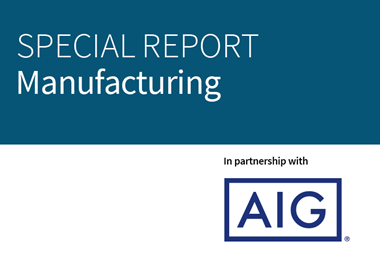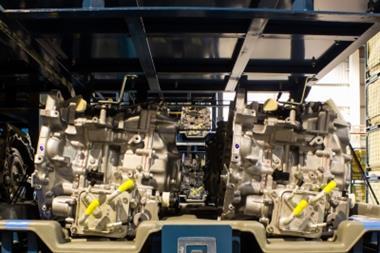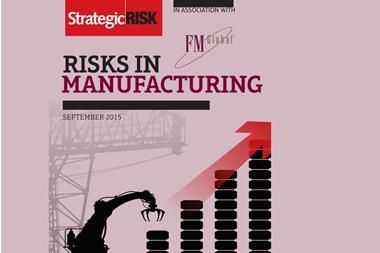Space weather concerns may not be top of the risk agenda for manufacturers but research from Cambridge University should be heeded by those most vulnerable

Major manufacturing businesses need little reminder of the potential impact that natural catastrophes can have on production. The events of 2011 in Fukushima, Japan, and the flooding in Thailand the same year have almost become clichés in this regard but continue to serve as a stark demonstration of the damage that can be caused to global supply chains by a regional event.
Nonetheless, these impacts risk being dwarfed by the potential consequences of a rare weather phenomenon triggered beyond earth – a catastrophic solar storm.
Here, in what is known as a coronal mass ejection, the sun throws out a massive explosion of billions of tons of charged particles and magnetic fields that hit the earth with less than an hour’s warning, destroying any electrical system in its direct path.
Researchers at Cambridge University’s Centre for Risk Studies have been examining the possibility of such an event and calculating potential losses. Its Helios Solar Storm Scenario is a hypothetical example, based on historical and contemporary evidence, of such an extreme event.
According to the Cambridge study, a catastrophic solar storm that takes out US generating capacity could result in business interruption and supply chain losses in the US and around the world of more than US $470billion, on a conservative measurement.
Depending on precisely where it hits, the CME would cause immediate power blackouts initially affecting 90 million US citizens or 28% of the US population. The power outage would also affect interdependent infrastructure systems, disrupting transport, digital communications, water, health and financial services. Outages could last a few days or many months, depending on the severity and impact of the CME.
The manufacturing sector would be hit hardest as Centre research associate Dr Edward Oughton explains: “Manufacturing is, at least in the scenario that we carried out, the most affected.
“Manufacturing here is more than just a single sector. It is a major portion of the economy that represents a lot of individual sectors. If you compared it to the size of services, which is obviously huge in the US economy, it would not be the largest sector affected but this is partly due to the accounting methodology used. I want to emphasise that manufacturing is a huge sector in the US economy and it is also huge in many European economies – and they are predominantly high value businesses as well. We need to recognise that fact.”
Large impact zone
Manufacturing is especially vulnerable because of the length and complexity of supply chains used by many companies in the sector.
“If you are building a car then the likelihood is that due to specialisation you will be getting components from all round the world,” Dr Oughton says. “So-called ‘just in time’ production also means you are more at risk if you do have a supply chain failure because you don’t have a big inventory that you are able to draw from.
“If you have an extreme space weather event and it knocks out your electricity system then there is a potentially large area with no electricity and therefore you get a very large impact zone. The direct effects are on all the companies that are immediately within the blackout zone but then ultimately you have firms outside of there that are either upstream or downstream in the production process. As a consequence, because of the very long supply chains in manufacturing you end up with a large amount of disruption throughout the economic system.”
Despite the potential impact, risk mitigation strategies are of limited effectiveness. With latitude 50 and 55 degrees geomagnetic the most vulnerable – an area known as the auroral electrojet region which includes cities such as London, New York, Paris and Chicago – manufacturers could transfer their production facilities elsewhere but this will do little to stop supply chain impact.
The cost of moving would also usually be prohibitive for most manufacturers given the potential event likelihood.
“The issue here is that it is a low probability, high severity event,” Dr Oughton says.
“I have spoken with engineers about this and the costs of installing protectors for transformer assets and replacing them every ten years are astronomical, so this is not an option in terms of mitigation.”
Developing an early warning system that would give governments and some businesses time to react and protect vital equipment appears the most cost effective way forward, he says.
Dr Oughton says the space weather community is “highly interested in our research” and wants to know if they should be investing in launching more satellites to identify space weather effects and give more warning.
“If you have more warning then you are able to do more things with the electrical grid – you can turn it off or change how you are working to make it more resilient,” he says.
The earlier the warning, the more time there is to prepare.
“It can take between three and four days to implement all the mitigation plans,” Dr Oughton says. “In the grand scheme of things the UK and the Nordic countries are relatively well prepared compared with other countries.
“Looking at some of our anecdotal evidence, the US is less prepared, partly because of the way its system is set up. We do not have any idea about how China might respond to something like this.”
Shutting down vital equipment cannot always be done quickly enough, however, according to Adrian Clements, corporate operational risk manager at steel producer ArcelorMittal.
“You need a certain period of time to empty out the liquid steel and this is something you don’t test because even though a blast furnace is massive it is also quite delicate.
“One of the problems we would have is coke because you can’t shut that system down. Anything producing coke or charcoal, whether it is steel or the cement industry, you cannot turn off because of thermal shock, otherwise it will break and you cannot rebuild the system. You could not shut these down in 18 hours, five days would be needed to cool them and there is nothing you can do about this.”
Develop resilience
Developing an effective response to such events is problematic and this is one reason why AIG has been supporting the Cambridge University team around solar storm risk and other research.
Fabrice Brossart, chief risk officer for international operations at AIG, says reducing fear is the role of the insurer in terms of events with low or difficult to determine probability but a huge potential impact.
“One of the aims of AIG is to understand the potential impact to help develop resilience,” says Brossart. “We want to make sure we protect our insured companies so that they are not exposed to any extreme scenarios. We are very concerned about the supply chain situation, for example.
“When it comes to exposure that cross-cuts several industries, the impact on insurance is really on contingent business interruption. In terms of manufacturing, when transformers go offline they have to be repaired and a number of them will have to be replaced. There are not plenty of these in storage in reserve just waiting to go online.”
Transformers can cost US $10-20million each and take up to three years to build.
Even if a manufacturer was willing to bear the cost there is little to be gained from keeping spares just in case “because they are likely to be fried as well”, says Clements unless they are kept in another region.
Brossart says that increasing numbers of AIG’s customers are turning to the insurer for help to develop scenarios and to plan for resilience on a range of large scale disaster scenarios.
“They want advice on contingency planning and risk management,” he says.
The consequences of a major solar storm could be one of the biggest business disruption events in history, not only for manufacturing but across all major sectors.
It could also trigger insurance payouts to dwarf almost anything seen before.
“This is not a peril that is mentioned specifically so the interpretation is that you are covered as per the terms of the policy – there is no exclusion of solar storms in general in our policies,” Brossart says.
Despite the likelihood of a catastrophic solar storm being a one in 150-200 year event, raising awareness of such a prospect is important in terms of assessing the preparedness of a business to deal with other risks, Brossart says.
“It helps insurers develop a better understanding of who is good at managing and who is less good at managing,” he says.
Extreme space weather events affecting Earth
1859 – The Carrington Event, regarded as one of the largest ever solar storms, caused significant disruption to telegraph systems.
1921 – Similar in size to the Carrington Event, a storm caused fires at several telegraph stations in Sweden.
1958 – Transatlantic communications were disrupted between Newfoundland and Scotland. There was a blackout in the Toronto area.
1989 – It took only 90 seconds for the entire Quebec power grid to collapse. The well-documented Quebec power outage lasted nine hours.
2003 – The Halloween Storms led to a one-hour power outage in Sweden, a radio blackout of high frequency communications and disruption to GPS systems.
2012 – Major solar eruptive event on Carrington scale went through Earth orbit. A week earlier and Earth would have been directly affected.




















No comments yet